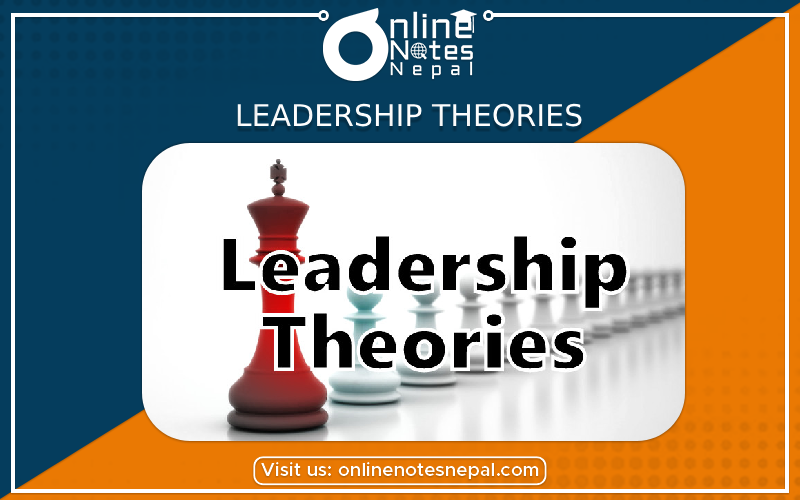Published by: Dikshya
Published date: 27 Jul 2023

1. Trait Theory of Leadership:
- Overview: The trait theory of leadership suggests that certain inherent traits or characteristics distinguish effective leaders from non-leaders. It emerged in the early 20th century and was one of the earliest theories of leadership.
- Key Traits: The trait theory focuses on identifying specific qualities that make individuals natural leaders. Some commonly studied traits include intelligence, confidence, charisma, emotional intelligence, determination, decisiveness, adaptability, and integrity.
- Assumptions: This theory assumes that leaders are born with these inherent traits and that leadership cannot be developed through training or experience.
Limitations: The trait theory has faced criticism for oversimplifying leadership and overlooking situational factors that influence leadership effectiveness. It also fails to provide a comprehensive list of traits that guarantee successful leadership.
2. Behavioral Theory of Leadership:
- Overview: The behavioral theory emphasizes that effective leadership is not solely based on inherent traits but can be learned and developed through observable behaviors. It emerged as a response to the limitations of the trait theory.
- Leadership Styles: The behavioral theory identifies two main leadership styles: a. Task-Oriented: Leaders who are focused on achieving goals, setting expectations, and clarifying roles. They prioritize the completion of tasks and emphasize productivity. b. People-Oriented: Leaders who prioritize building relationships, motivating team members, and addressing their needs. They focus on the well-being and satisfaction of their followers.
- Assumptions: This theory assumes that leaders can be trained to exhibit effective behaviors and that leadership effectiveness is influenced by the leader's actions.
Limitations: The behavioral theory doesn't take into account individual differences and the impact of situational factors on leadership effectiveness.
3. Fiedler's Contingency Theory:
- Overview: Developed by Fred Fiedler in the 1960s, the contingency theory of leadership suggests that leadership effectiveness depends on the interaction between a leader's style and the favorability of the situation. It considers the match between the leader's style and the situational demands.
- Leadership Styles: Fiedler classified leaders into two styles based on their orientation: a. Task-Oriented: Leaders who are more concerned with completing tasks and achieving objectives. b. Relationship-Oriented: Leaders who prioritize building strong relationships within the team.
- Situational Favorability: The theory identifies three situational factors that determine the favorability of a situation for a particular leader: a. Leader-Member Relations: The degree of trust and rapport between the leader and the team members. b. Task Structure: The extent to which tasks are clear and well-defined. c. Position Power: The level of authority and power granted to the leader by the organization.
- Matching Leadership Style: Fiedler's theory suggests that the most effective leaders are those whose styles match the situational demands.
Limitations: Fiedler's Contingency Theory has faced criticism for its complex measurement techniques and limited practical application. Critics argue that it oversimplifies leadership and neglects the leader's ability to adapt to different situations.
4. Managerial Grid:
- Overview: The Managerial Grid is a leadership model developed by Robert Blake and Jane Mouton in the 1960s. It assesses a leader's concern for people and concern for production and places them on a two-dimensional grid.
- Leadership Styles: The model identifies five leadership styles based on different combinations of concern for people and concern for production:
a. Impoverished Management (low concern for people and production): Leaders with this style show little interest in both people and tasks, leading to a hands-off approach.
b. Country Club Management (high concern for people, low concern for production): Leaders with this style focus on creating a friendly work environment and building strong relationships but may neglect productivity.
c. Middle-of-the-Road Management (balanced concern for people and production): Leaders with this style aim for moderate performance levels in both people and tasks, avoiding extremes.
d. Authority-Compliance (high concern for production, low concern for people): Leaders with this style prioritize task accomplishment and efficiency but may disregard the well-being of their team members.
e. Team Management (high concern for people and production): Leaders with this style strike a balance between people and task orientation, emphasizing collaboration and high performance.
- Assumptions: The Managerial Grid assumes that the ideal leadership style is Team Management, where both people and task concerns are high.
Limitations: Critics argue that the model oversimplifies leadership and may not fully capture the complexities of real-life leadership situations.
5. Path-Goal Theory of Leadership:
- Overview: The Path-Goal theory of leadership was developed by Robert House in the 1970s. It focuses on how leaders can motivate and support their followers to achieve their goals by clarifying the path and removing obstacles.
- Leadership Styles: The theory proposes four leadership styles based on the leader's behaviors:
a. Directive Leadership: Providing clear guidance and expectations to followers to accomplish their tasks.
b. Supportive Leadership: Showing concern for followers' well-being and creating a friendly work environment to foster a positive atmosphere.
c. Participative Leadership: Involving followers in decision-making and considering their input to increase their commitment.
d. Achievement-Oriented Leadership: Setting challenging goals and expressing high expectations to inspire followers' performance.
- Contingency Factors: The theory suggests that the most effective leadership style depends on situational factors such as task structure, follower characteristics, and external environment. For example, a directive style may be more appropriate when tasks are ambiguous, while a supportive style may be beneficial in high-stress situations.
- Assumptions: The Path-Goal theory assumes that leaders should adapt their leadership style to support their followers in achieving their goals effectively.
- Limitations: The Path-Goal theory may not fully explain the complex nature of leadership, and critics argue that it lacks strong empirical evidence.
Each of these leadership theories offers valuable insights into understanding leadership and its various dimensions. It's important to recognize that effective leadership often involves a combination of traits, behaviors, and situational adaptability. Leadership theories continue to evolve as researchers and practitioners seek to better understand the nuances of leadership effectiveness.